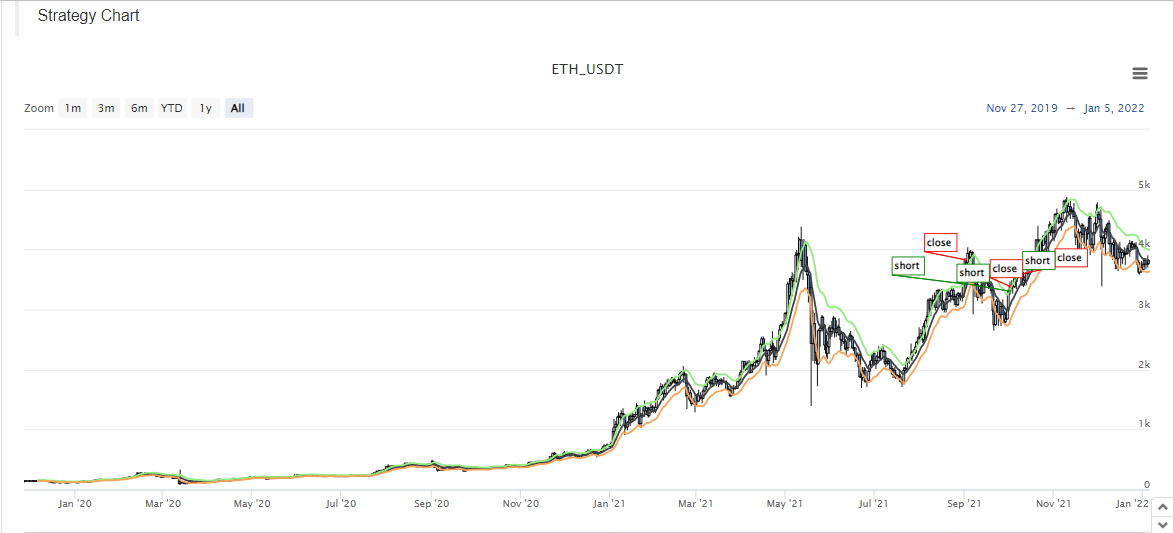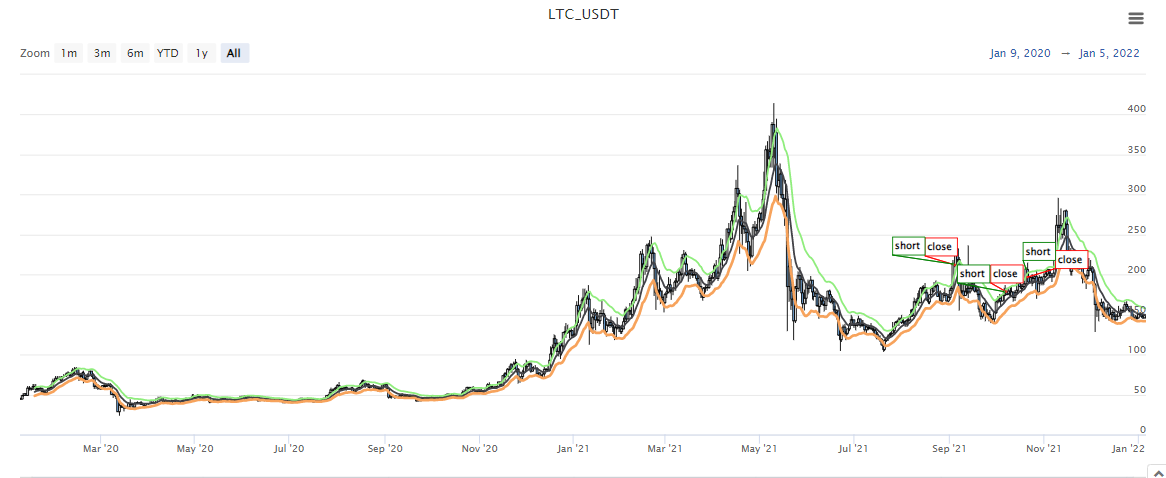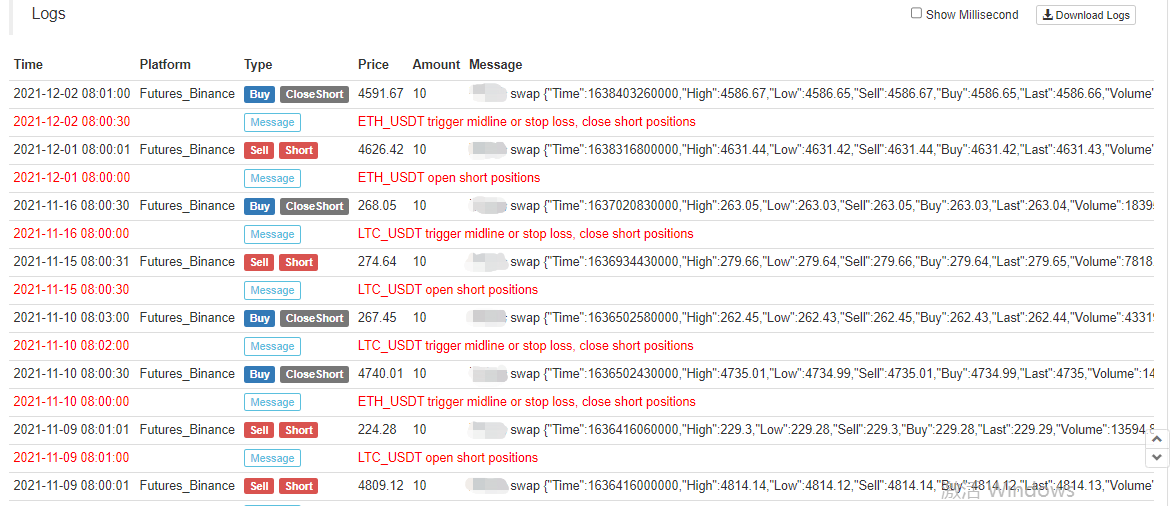Estrategia ATR multiespecie de futuros de divisas digitales (tutorial)
El autor:- ¿ Por qué?, Creado: 2022-11-08 10:34:22, Actualizado: 2023-09-15 20:55:33
Recientemente, algunos de nuestros usuarios de la plataforma están deseando trasplantar una estrategia MyLanguage en una estrategia JavaScript, que puede agregar de manera flexible muchas ideas de optimización. Incluso ampliar la estrategia a versiones de múltiples especies. Debido a que la estrategia MyLanguage es generalmente una estrategia de tendencia, y muchas de ellas se ejecutan basadas en el modelo de precio de cierre. La interfaz API del intercambio de solicitudes de estrategia no es muy frecuente, lo que es adecuado para trasplantar a una versión de estrategia de múltiples especies. En este artículo, tomaremos una estrategia MyLanguage simple como ejemplo para trasplantarla en una versión simple del lenguaje JavaScript. El propósito principal es la enseñanza y la investigación de respaldo.
La estrategia de MyLanguage para trasplantarse
TR:=MAX(MAX((H-L),ABS(REF(C,1)-H)),ABS(REF(C,1)-L));
ATR:=EMA(TR,LENGTH2);
MIDLINE^^EMA((H + L + C)/3,LENGTH1);
UPBAND^^MIDLINE + N*ATR;
DOWNBAND^^MIDLINE - N*ATR;
BKVOL=0 AND C>=UPBAND AND REF(C,1)<REF(UPBAND,1),BPK;
SKVOL=0 AND C<=DOWNBAND AND REF(C,1)>REF(DOWNBAND,1),SPK;
BKVOL>0 AND C<=MIDLINE,SP(BKVOL);
SKVOL>0 AND C>=MIDLINE,BP(SKVOL);
// stop loss
// stop loss
C>=SKPRICE*(1+SLOSS*0.01),BP;
C<=BKPRICE*(1-SLOSS*0.01),SP;
AUTOFILTER;
La lógica de negociación de esta estrategia es simple. Primero, calcule ATR de acuerdo con los parámetros, luego calcule el promedio de los precios más altos, más bajos y de cierre de todos los BAR de la línea K, y luego calcule el indicador EMA de acuerdo con los datos promedio. Finalmente, combine ATR y el coeficiente N en los parámetros para calcular la upBand y downBand.
Las posiciones de apertura y venta se basan en el precio de cierre. Abre posiciones largas cuando supera la banda ascendente y vende la posición de apertura (cuando mantiene posiciones cortas). Abre posiciones cortas cuando supera la banda descendente y vende la posición de apertura. Cuando el precio de cierre alcance la línea media, la posición se cerrará, y cuando el precio de cierre alcance el precio de stop loss, la posición también se cerrará (de acuerdo con el SLOSS, el stop loss es 1, es decir, 0,01, es decir, 1%). La estrategia se ejecuta en un modelo de precio de cierre.
OK, si entendemos los requisitos estratégicos e ideas de MyLanguage, podemos comenzar a trasplantarlos.
Prototipo de estrategia de trasplante y diseño
Para facilitar el aprendizaje de las ideas de escritura de estrategias, los comentarios se escriben directamente en el código de estrategia.
// parse params parameters, and parse strings as objects
var arrParam = JSON.parse(params)
// this function creates a chart configuration
function createChartConfig(symbol, atrPeriod, emaPeriod, index) { // symbol : trading pair, atrPeriod : ATR parameter period , emaPeriod : EMA parameter period, exchange object index corresponding to index
var chart = {
__isStock: true,
extension: {
layout: 'single',
height: 600,
},
title : { text : symbol},
xAxis: { type: 'datetime'},
series : [
{
type: 'candlestick', // K-line data series
name: symbol,
id: symbol + "-" + index,
data: []
}, {
type: 'line', // EMA
name: symbol + ',EMA:' + emaPeriod,
data: [],
}, {
type: 'line', // upBand
name: symbol + ',upBand' + atrPeriod,
data: []
}, {
type: 'line', // downBand
name: symbol + ',downBand' + atrPeriod,
data: []
}, {
type: 'flags',
onSeries: symbol + "-" + index,
data: [],
}
]
}
return chart
}
// main Logic
function process(e, kIndex, c) { // e is the exchange object, exchanges [0]..., kIndex is the K-line data series in the chart, and c is the chart object
// obtain K-line data
var r = e.GetRecords(e.param.period)
if (!r || r.length < e.param.atrPeriod + 2 || r.length < e.param.emaPeriod + 2) {
// if the K-line data length is insufficient, return
return
}
// calculate ATR indicators
var atr = TA.ATR(r, e.param.atrPeriod)
var arrAvgPrice = []
_.each(r, function(bar) {
arrAvgPrice.push((bar.High + bar.Low + bar.Close) / 3)
})
// calculate EMA indicators
var midLine = TA.EMA(arrAvgPrice, e.param.emaPeriod)
// calculate upBand and downBand
var upBand = []
var downBand = []
_.each(midLine, function(mid, index) {
if (index < e.param.emaPeriod - 1 || index < e.param.atrPeriod - 1) {
upBand.push(NaN)
downBand.push(NaN)
return
}
upBand.push(mid + e.param.trackRatio * atr[index])
downBand.push(mid - e.param.trackRatio * atr[index])
})
// draw the chart
for (var i = 0 ; i < r.length ; i++) {
if (r[i].Time == e.state.lastBarTime) {
// update
c.add(kIndex, [r[i].Time, r[i].Open, r[i].High, r[i].Low, r[i].Close], -1)
c.add(kIndex + 1, [r[i].Time, midLine[i]], -1)
c.add(kIndex + 2, [r[i].Time, upBand[i]], -1)
c.add(kIndex + 3, [r[i].Time, downBand[i]], -1)
} else if (r[i].Time > e.state.lastBarTime) {
// add
e.state.lastBarTime = r[i].Time
c.add(kIndex, [r[i].Time, r[i].Open, r[i].High, r[i].Low, r[i].Close])
c.add(kIndex + 1, [r[i].Time, midLine[i]])
c.add(kIndex + 2, [r[i].Time, upBand[i]])
c.add(kIndex + 3, [r[i].Time, downBand[i]])
}
}
// check the position
var pos = e.GetPosition()
if (!pos) {
return
}
var holdAmount = 0
var holdPrice = 0
if (pos.length > 1) {
throw "long and short positions are checked at the same time!"
} else if (pos.length != 0) {
holdAmount = pos[0].Type == PD_LONG ? pos[0].Amount : -pos[0].Amount
holdPrice = pos[0].Price
}
if (e.state.preBar == -1) {
e.state.preBar = r[r.length - 1].Time
}
// check the signal
if (e.state.preBar != r[r.length - 1].Time) { // closing price model
if (holdAmount <= 0 && r[r.length - 3].Close < upBand[upBand.length - 3] && r[r.length - 2].Close > upBand[upBand.length - 2]) { // the closing price cross over the upBand
if (holdAmount < 0) { // hold a short positions, close them
Log(e.GetCurrency(), "close short positions", "#FF0000")
$.CoverShort(e, e.param.symbol, Math.abs(holdAmount))
c.add(kIndex + 4, {x: r[r.length - 2].Time, color: 'red', shape: 'flag', title: 'close', text: "close short positions"})
}
// open long positions
Log(e.GetCurrency(), "open long positions", "#FF0000")
$.OpenLong(e, e.param.symbol, 10)
c.add(kIndex + 4, {x: r[r.length - 2].Time, color: 'red', shape: 'flag', title: 'long', text: "open long positions"})
} else if (holdAmount >= 0 && r[r.length - 3].Close > downBand[downBand.length - 3] && r[r.length - 2].Close < downBand[downBand.length - 2]) { // the closing price cross down the downBand
if (holdAmount > 0) { // hold long positions, close them
Log(e.GetCurrency(), "close long positions", "#FF0000")
$.CoverLong(e, e.param.symbol, Math.abs(holdAmount))
c.add(kIndex + 4, {x: r[r.length - 2].Time, color: 'green', shape: 'flag', title: 'close', text: "close long positions"})
}
// open short positions
Log(e.GetCurrency(), "open short positions", "#FF0000")
$.OpenShort(e, e.param.symbol, 10)
c.add(kIndex + 4, {x: r[r.length - 2].Time, color: 'green', shape: 'flag', title: 'short', text: "open short positions"})
} else {
// close positions
if (holdAmount > 0 && (r[r.length - 2].Close <= holdPrice * (1 - e.param.stopLoss) || r[r.length - 2].Close <= midLine[midLine.length - 2])) { // Hold a long position, the closing price is less than or equal to the midline, stop loss at the opening price
Log(e.GetCurrency(), "trigger midline or stop loss, close long positions", "#FF0000")
$.CoverLong(e, e.param.symbol, Math.abs(holdAmount))
c.add(kIndex + 4, {x: r[r.length - 2].Time, color: 'green', shape: 'flag', title: 'close', text: "close long positions"})
} else if (holdAmount < 0 && (r[r.length - 2].Close >= holdPrice * (1 + e.param.stopLoss) || r[r.length - 2].Close >= midLine[midLine.length - 2])) { // Hold a short position, the closing price is greater than or equal to the midline, stop loss at the opening price
Log(e.GetCurrency(), "trigger midline or stop loss, close short positions", "#FF0000")
$.CoverShort(e, e.param.symbol, Math.abs(holdAmount))
c.add(kIndex + 4, {x: r[r.length - 2].Time, color: 'red', shape: 'flag', title: 'close', text: "close short positions"})
}
}
e.state.preBar = r[r.length - 1].Time
}
}
function main() {
var arrChartConfig = []
if (arrParam.length != exchanges.length) {
throw "Parameters and exchange objects do not match!"
}
var arrState = _G("arrState")
_.each(exchanges, function(e, index) {
if (e.GetName() != "Futures_Binance") {
throw "The exchange is not supported!"
}
e.param = arrParam[index]
e.state = {lastBarTime: 0, symbol: e.param.symbol, currency: e.GetCurrency()}
if (arrState) {
if (arrState[index].symbol == e.param.symbol && arrState[index].currency == e.GetCurrency()) {
Log("restore:", e.state)
e.state = arrState[index]
} else {
throw "The restored data does not match the current settings!"
}
}
e.state.preBar = -1 // initial setting -1
e.SetContractType(e.param.symbol)
Log(e.GetName(), e.GetLabel(), "set contracts:", e.param.symbol)
arrChartConfig.push(createChartConfig(e.GetCurrency(), e.param.atrPeriod, e.param.emaPeriod, index))
})
var chart = Chart(arrChartConfig)
chart.reset()
while (true) {
_.each(exchanges, function(e, index) {
process(e, index + index * 4, chart)
Sleep(500)
})
}
}
function onexit() {
// record e.state
var arrState = []
_.each(exchanges, function(e) {
arrState.push(e.state)
})
Log("record:", arrState)
_G("arrState", arrState)
}
Parámetros de la estrategia:
var params = '[{
"symbol" : "swap", // contract code
"period" : 86400, // K-line period, 86,400 seconds is a day
"stopLoss" : 0.07, // stop loss factor, 0.07 or 7%
"atrPeriod" : 10, // ATR indicator parameters
"emaPeriod" : 10, // EMA indicator parameters
"trackRatio" : 1, // upBand and downBand coefficients
"openRatio" : 0.1 // The reserved opening percentage, which is not supported for now
}, {
"symbol" : "swap",
"period" : 86400,
"stopLoss" : 0.07,
"atrPeriod" : 10,
"emaPeriod" : 10,
"trackRatio" : 1,
"openRatio" : 0.1
}]'
Capturas de pantalla de pruebas de retroceso:



Código fuente de la estrategia:https://www.fmz.com/strategy/339344
Las estrategias son para backtesting y investigación de aprendizaje solamente. Por favor, modifique, optimice, y haga referencia al bot real por usted mismo.
- Cuantificar el análisis fundamental en el mercado de criptomonedas: ¡Deja que los datos hablen por sí mismos!
- La investigación cuantitativa básica del círculo monetario - ¡No confíes más en los profesores de idiomas, los datos hablan objetivamente!
- Una herramienta esencial en el campo de la transacción cuantitativa - inventor de módulos de exploración de datos cuantitativos
- Dominarlo todo - Introducción a FMZ Nueva versión de la terminal de negociación (con el código fuente de TRB Arbitrage)
- Conozca todo acerca de la nueva versión del terminal de operaciones de FMZ (con código de código de TRB)
- FMZ Quant: Análisis de ejemplos de diseño de requisitos comunes en el mercado de criptomonedas (II)
- Cómo explotar robots de venta sin cerebro con una estrategia de alta frecuencia en 80 líneas de código
- Cuantificación FMZ: Desarrollo de casos de diseño de necesidades comunes en el mercado de criptomonedas (II)
- Cómo utilizar una estrategia de alta frecuencia de 80 líneas de código para explotar y vender robots sin cerebro
- FMZ Quant: Análisis de ejemplos de diseño de requisitos comunes en el mercado de criptomonedas (I)
- Cuantificación FMZ: Desarrollo de casos de diseño de necesidades comunes en el mercado de criptomonedas (1)